Shuttle SK83G: FX83 Motherboard
| Motherboard Specifications | |
| CPU Interface | Socket 754 Athlon 64 |
| Chipset | VIA K8M800 + VIA VT8237 |
| CPU Ratios | None |
| Bus Speeds | 200MHz to 232MHz (in 1MHz increments) |
| PCI/AGP Speeds | None |
| HyperTransport | 1x-4x (200MHz to 800MHz) |
| Core Voltage | up to 1.70V in 0.0250V and 0.050V increments |
| DRAM Voltage | 2.5V to 2.8V in 0.1V increments |
| AGP Voltage | 1.5V to 1.8V in 0.1V increments |
| Chipset Voltage | 1.3V to 1.5V in 0.1V increments |
| Memory Slots | Two 184-pin DDR DIMM Slots |
| Expansion Slots | 1 AGP 8X Slot 1 PCI Slot |
| Onboard SATA/RAID | 2 X SATA connectors 2 X ATA100 connectors RAID 0, RAID 1 |
| Onboard IDE | Two Standard NVIDIA ATA133/100/66 |
| Onboard USB 2.0/IEEE-1394 | 6 X USB 2.0 ports (2 front, 4 rear) power by VT8237 One rear FireWire port powered by VT6307 |
| Onboard LAN | VIA VT6103 10/100 Ethernet |
| Onboard Audio | Realtek ALC650 codec (6 channel sound) |
VIA's VT6103 LAN chip is a standard 10/100 Ethernet solution that will meet the needs of the average Internet user and home networking user, provided they don't transfer very large amounts of data very often in their home network. That is, a 10/100 solution is adequate for transferring large amounts of data, but it just isn't nearly as fast as 10/100/1000 (dubbed GbE, or Gigabit Ethernet). We bring GbE up because the Shuttle SK83G is competing with nForce3 250Gb SFFs, which natively support GbE for free.
The Shuttle SK83G also comes with a basic 6-channel sound, courtesy of Realtek's ALC650. We're surprised and mildly disappointed that the SK83G didn't come with a more updated version of this codec, specifically the 8-channel ALC680. But still, you will receive quite acceptable sound via this codec. We did our own subjective testing over a period of a week and found no common issues, like crackling or high CPU utilization, during music play.
Of course, the most important piece of the SK83G puzzle lies in its chipset. Comprised of the K8M800 North Bridge and VT8237 South Bridge, this chipset's primary advantage over others is its integrated video. VIA's integrated video, dubbed the UniChrome II, is a basic integrated video solution that doesn't offer much more usability or value than as just a backup video processor. In other words, if you can buy a separate video card, we suggest that you do so; as a result, you'll likely experience noticeably better 2D and 3D acceleration. But as backup video, the UniChrome II is more than acceptable.













18 Comments
View All Comments
cosmotic - Wednesday, July 14, 2004 - link
Am I the only one that wants to know how they got NVIDIA IDE controllers on VIA chipset motherboards? Ether that, or your specs are wrong.Wesley Fink - Wednesday, July 14, 2004 - link
#3 - You might be surprised at how some use their SFF machines. For example, the Shuttle SFF based on the 875 chipset has become a darling of the Extreme Overclocking crowd. In fact, I know 2 users who run their 875 SFF with mobile processors for low heat, the FSB at 300FSB, and top-end video. They take the machines to LAN parties.We always publish stock performance metrics as our baseline. If you don't personally care about overclocking an SFF, then just skip that information. We understand overclocking info is not important to some, but it does matter to others.
ggnl - Wednesday, July 14, 2004 - link
Good review. Very informative, but I have a problem.The pictures are just fugly! I don't understand why you couple great analysis of the hardware with blurry, out of focus, poorly lit photographs.
And it's not just this review, most of the reveiws on this site have the same crappy pictures. Please...pretty please with sugar on top...send one or two of your tech gurus to a basic studio photography class at the local community college and get a camara with decent macro ability. What did you do with that Canon 10D you reviewed a few weeks ago?
This from the site that's going to be bringing you camera reviews...
overclockingoodness - Wednesday, July 14, 2004 - link
nserra #3 - I can't disagree with you more.1. These systems are mainly designed as portable LAN machines for enthusiasts. And since AT is an enthusiasts, it makes sense to overclock the systems. Almost every site posts overclocking reslts, which makes complete sense.
2. Why not? Many enthusiasts want best performance from these little PCs. If you want the best gaming performance, it makes complete sense to include a 6800 Ultra and/or 9800. I think you are the one with a messed up mind. So you are saying that having an Athlon64 chip is right, but having a high-end video card is wrong? Why the heck would someone want a high-end CPU if they are not going to do gaming? Your arguments are useless.
3. Yeah, I agree with that BUT these systems are not for small businesses and schools who are not going to do anything with it. Don't forget that these systems are tragetted towards enthusiasts and nicely enough SFF proves be to a good form factor for space conscious users.
4. Yep, agreed.
5. You are wrong again. AnandTech has a selected benchmark suites which they use everytime to compare performance against competitor's products. If they were to start using new gaming and new testing methods for each product review, we, as readers, won't be able to understand the difference between each product and/or AnandTech will have to review 10 systems over and over again, which is a huge time wastage.
I give you some credit for your post but all the important points are bogus and utterly useless. Please check your facts and by the way if these reviews are getting boring...then why in the world are you even reading them. Stop complaining and do not ask AnandTech to change the testing methods upside down just because you. You are not special, in fact, you are one of the ignorant readers who doesn't know a thing about computers.
nserra - Wednesday, July 14, 2004 - link
Guys, these reviews are starting to get boring.1st - I don’t see the point of testing over clocking capabilities on "cube" PC's, it's ridiculous. The people at the market these products are aimed, this is not important, especially on such small systems, who want to do that.
2nd - I don’t see the point of buying a such small system and put a Geforce 6800 or even an ati 9800, the person that does that is not in it right mind.
3rd - the review of a system like these is more important sound quality and video quality playback as 2D display quality, and specially functionality or "extras" that systems like these have.
4th - The noise the system make while is working is also very important.
5th – And really these charts that always look the same are getting boring, or you start choosing applications/games that show “significant” differences between the various chipsets or these review get boring to read.
Jeff7181 - Wednesday, July 14, 2004 - link
I don't understand why this is "AMD's shot at SFF."Shuttle has had AMD based SFF computers for a while now... is the processor a special SFF processor or something?
Sonic587 - Wednesday, July 14, 2004 - link
On the Quake 3 Arena w/Unichrome benches, could you move the FPS results further to the right? You've got some text overlapping there and it's quite hard for me to read what FPS was obtained.Other than that, nice review.
Gbugmenot - Thursday, October 17, 2013 - link
The difference between you and the others like the ones who make posts at http://www.stackfront.com is not much. You must be a 12yr old child who think know everything about computers, have you ever come out from your house and see the true world, the true reality? Have talked with other people non computer fanatics like your self? Regular PC users? Do you know about their needs? What they really want?From all the video cards in the world how many you do think are overclocked? 1/10000 1/1000 1/100? 1/10?